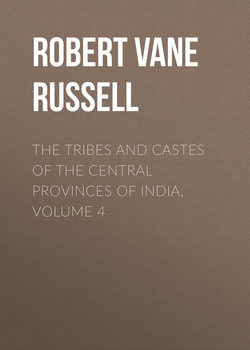Читать книгу The Tribes and Castes of the Central Provinces of India, Volume 4 - Robert Vane Russell - Страница 32
Part II
Articles on Castes and Tribes
Kumhār—Yemkala
Vol. IV
Kunbi
19. Villages and houses
ОглавлениеAn ordinary Kunbi village38 contains between 70 and 80 houses or some 400 souls. The village generally lies on a slight eminence near a nullah or stream, and is often nicely planted with tamarind or pīpal trees. The houses are now generally tiled for fear of fire, and their red roofs may be seen from a distance forming a little cluster on high lying ground, an elevated site being selected so as to keep the roads fairly dry, as the surface tracks in black-soil country become almost impassable sloughs of mud as soon as the rains have broken. The better houses stand round an old mud fort, a relic of the Pindāri raids, when, on the first alarm of the approach of these marauding bands, the whole population hurried within its walls. The village proprietor’s house is now often built inside the fort. It is an oblong building surrounded by a compound wall of unbaked bricks, and with a gateway through which a cart can drive. Adjoining the entrance on each side are rooms for the reception of guests, in which constables, chuprāssies and others are lodged when they stay at night in the village. Kothas or sheds for keeping cattle and grain stand against the walls, and the dwelling-house is at the back. Substantial tenants have a house like the proprietor’s, of well-laid mud, whitewashed and with tiled roof; but the ordinary cultivator’s house is one-roomed, with an angan or small yard in front and a little space for a garden behind, in which vegetables are grown during the rains. The walls are of bamboo matting plastered over with mud. The married couples sleep inside, the room being partitioned off if there are two or more in the family, and the older persons sleep in the verandahs. In the middle of the village by the biggest temple will be an old pīpal tree, the trunk encircled by an earthen or stone platform, which answers to the village club. The respectable inhabitants will meet here while the lower classes go to the liquor-shop nearly every night to smoke and chat. The blacksmith’s and carpenter’s shops are also places of common resort for the cultivators. Hither they wend in the morning and evening, often taking with them some implement which has to be mended, and stay to talk. The blacksmith in particular is said to be a great gossip, and will often waste much of his customer’s time, plying him for news and retailing it, before he repairs and hands back the tool brought to him. The village is sure to contain two or three little temples of Māroti or Mahādeo. The stones which do duty for the images are daily oiled with butter or ghī, and a miscellaneous store of offerings will accumulate round the buildings. Outside the village will be a temple of Devi or Māta Mai (Smallpox Goddess) with a heap of little earthen horses and a string of hens’ feet and feathers hung up on the wall. The little platforms which are the shrines of the other village gods will be found in the fields or near groves. In the evening the elders often meet at Māroti’s temple and pay their respects to the deity, bowing or prostrating themselves before him. A lamp before the temple is fed by contributions of oil from the women, and is kept burning usually up to midnight. Once a year in the month, of Shrāwan (July) the villagers subscribe and have a feast, the Kunbis eating first and the menial and labouring castes after them. In this month also all the village deities are worshipped by the Joshi or priest and the villagers. In summer the cultivators usually live in their fields, where they erect temporary sheds of bamboo matting roofed with juāri stalks. In these most of the household furniture is stored, while at a little distance in another funnel-shaped erection of bamboo matting is kept the owner’s grain. This system of camping out is mainly adopted for fear of fire in the village, when the cultivator’s whole stock of grain and his household goods might be destroyed in a few minutes without possibility of saving them. The women stay in the village, and the men and boys go there for their midday and evening meals.
38
These paragraphs are largely based on a description of a Wardha village by Mr. A.K. Smith, C.S.
